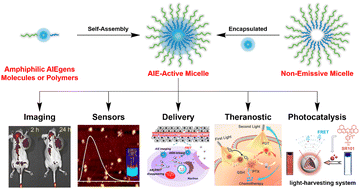Aggregation-induced emission-active micelles: synthesis, characterization, and applications
Abstract
Aggregation-induced emission (AIE)-active micelles are a type of fluorescent functional materials that exhibit enhanced emissions in the aggregated surfactant state. They have received significant interest due to their excellent fluorescence efficiency in the aggregated state, remarkable processability, and solubility. AIE-active micelles can be designed through the self-assembly of amphipathic AIE luminogens (AIEgens) and the encapsulation of non-emissive amphipathic molecules in AIEgens. Currently, a wide range of AIE-active micelles have been constructed, with a significant increase in research interest in this area. A series of advanced techniques has been used to characterize AIE-active micelles, such as cryogenic-electron microscopy (Cryo-EM) and confocal laser scanning microscopy (CLSM). This review provides an overview of the synthesis, characterization, and applications of AIE-active micelles, especially their applications in cell and in vivo imaging, biological and organic compound sensors, anticancer drugs, gene delivery, chemotherapy, photodynamic therapy, and photocatalytic reactions, with a focus on the most recent developments. Based on the synergistic effect of micelles and AIE, it is anticipated that this review will guide the development of innovative and fascinating AIE-active micelle materials with exciting architectures and functions in the future.



 Please wait while we load your content...
Please wait while we load your content...